Dairy-free formulas are used to feed children with one or another food allergy. Most often it is an allergy to cow's milk protein . Dairy-free formulas do not contain the components that cause this allergy - protein and lactose.
Dairy-free formulas are used only on the recommendation of a doctor and only as preventive nutrition for children.
Dairy-free formulas can be divided into:
- Dairy-free lactose-free mixtures;
- Dairy-free soy mixtures;
- Goat milk mixtures.
This division is somewhat arbitrary; in fact, a strictly dairy-free mixture is one that does not contain two components - lactose and milk protein .
Lactose-free mixtures do not contain only lactose.
Soy formulas contain soy isolate instead of milk protein.
Goat milk formulas contain goat milk as a source of amino acids, which is considered to be closer in composition to breast milk.
Distinctive features of hypoallergenic mixtures
Mother's breast milk is the best food for a newborn. However, not every woman manages to maintain lactation. Some have little milk, while others don’t have it at all.
In such situations, the pediatrician advises introducing a special mixture into complementary foods. There are many of them, not every newborn’s body assimilates them well: allergic reactions in the form of dysbacteriosis and redness on the skin are possible.
Hypoallergenic mixtures, for example, Nestozhen, will help to avoid such troubles. This is the name for specialized food (powders and ready-made formulations are available for sale), which is intended for the treatment and prevention of allergies in infants and children aged 6-12 months.
The main difference between hypoallergenic baby food and other types is that it does not contain natural milk proteins.
It cannot harm a baby who has an individual intolerance to cow's milk protein. For example, to prevent allergic manifestations, pediatricians recommend giving your child “Nestozhen”; this powder contains pro- and prebiotics that normalize intestinal function.
Not suitable for infants
Peculiarities
Dairy-free formulas are specialized nutrition for children, the purpose of which is to correct the symptoms of food allergies and prevent them.
The basis of dairy-free mixtures are either soy proteins , which are considered less allergenic than milk proteins, or protein hydrolysates. In hydrolyzed formulas, large milk molecules, which are highly allergenic, are broken down into smaller ones. Such molecules are absorbed much better, which does not lead to digestive problems.
Regular or adapted formulas, in turn, are as close in composition as possible to mother’s milk, that is, they have a high percentage of milk proteins.
Lactose-free formulas are intended for children intolerant of carbohydrates such as lactose and galactose. If a child does not have a food allergy to protein, then most often the protein component of lactose-free milk formulas is represented by whey proteins. In case of hypersensitivity to milk proteins, use dairy-free formulas that do not contain lactose.
The basic composition of dairy-free mixtures is represented by the following components:
- Base (hydrolyzed or soy).
- Vegetable oils.
- Amino acids.
- Vitamin complex.
- Minerals.
Formulas that do not contain milk proteins are used when feeding children with food allergies. Also used for babies with lactose intolerance and galactosemia.
Types of baby food
You can buy hypoallergenic “Nestozhen” and other HA mixtures in pharmacies or specialized stores (online stores). Their list is quite long.
According to their composition, they are divided into several groups:
- dairy-free (without cow's protein, contains soy protein; designed for children from birth, whose body does not absorb milk protein);
- low-lactose and lactose-free (designed for babies whose bodies cannot digest lactose);
- adapted protein, for example, hypoallergenic “Nestozhen” (prescribed if the allergy is severe; recommended for premature babies and infants who have been diagnosed with malnutrition - underweight);
- dairy without the amino acid phenylalanine (designed specifically for young patients with the hereditary disease “phenylketonuria” - the body’s inability to absorb amino acids that come from protein foods);
- gluten-free (recommended for children whose bodies do not digest cereals well).
The mixture is not suitable for children from 6 months
Preventative baby food
All HA mixtures are divided into two large groups: preventive and therapeutic. The first ones (these include “Nestozhen hypoallergenic”) contain partially split protein.
Article on the topic: What does a sweet allergy look like in children?
They are prescribed if:
- the child may develop allergies (for example, if his parents are allergic);
- the first signs of an allergy to cow's milk protein appeared (the mother eats a lot of dairy products, cow's milk protein enters the baby's body through breast milk);
- for three months there has been a remission (weakening, up to complete disappearance) of the allergy.
Unlike preventive formulas, therapeutic mixtures contain completely hydrolyzed (split) protein (it is divided into small molecules - peptides), which are better absorbed by the child’s body.
The following types of medicinal mixtures are known: whey, casein, soy.
Hypoallergenic baby food
Types of medicinal mixtures
Whey - contains substances obtained during the breakdown of whey. They have high nutritional value. They are prescribed to premature babies and those who are not gaining weight well.
But, according to reviews, some children refuse to eat such food. The reason is the bitter taste.
Casein eggs contain casein hydrolysate (a special type of protein in a split form that rarely causes allergies). Their nutritional value is lower, and the bitter taste is more pronounced.
They are prescribed for severe forms of allergies. The choice of appropriate nutrition is often determined by experience.
The composition of soy medicinal mixtures includes soy protein. This is a dairy-free, lactose-free diet. It is prescribed when a child is allergic to cow's or goat's milk.
But it contains fewer amino acids than infant formula, and these substances are necessary for the development of the central nervous system and the baby’s brain.
Dairy-free soy mixtures
The main protein substitute in soy mixtures is soy isolate . Its composition is close to milk protein and does not contain only methionine. But manufacturers add this component to the mixture separately.
Many parents doubt and do not want to feed their baby soy formula because of the prejudice that soy is a genetically modified product. This is wrong ! Infant formulas use only natural soy and other ingredients. The production and composition of baby food is strictly controlled by the state.
Soy formulas are very popular among parents whose babies are allergic to cow protein. However, they must be used with caution - the child may be allergic to soy . Soy formulas are dairy-free and lactose-free, but they are not hypoallergenic.
Also, soy formula is not recommended for feeding infants under six months of age.
List of soy mixtures
- Nutrilak Soya;
- Nutrilon Soy;
- Frisosoy;
- Humana SL;
- Enfamil Soya;
- Similak Izomil.
In general, the list of soy formulas is quite large; every major baby food manufacturer produces them. The packages are marked “Soy”.
Read more - soy formula for children.
Popular HA mixtures
Modern Russian and foreign manufacturers of hypoallergenic baby food offer a wide variety of products. Which one is better can be determined based on the advice of a pediatrician and reviews of mothers.
In addition, parents often use the trial and error method: they give the baby one powder or another and monitor their child’s reaction.
The list of the most popular brands is as follows:
- Nestozhen;
- NAS;
- Nutrilon;
- Baby;
- Nutrilak;
- Bellakt and others.
Popular hypoallergenic (HA) mixtures
Composition and advantages of "Nestozhen"
Hypoallergenic powder "Nestozhen" was developed by the Swiss company Nestle. It contains partially digested protein, prebiotics, probiotics, vitamins and minerals necessary for the child’s body.
The yellowish powder dissolves quickly in water, leaving no lumps. “Nestozhen” does not contain palm oil and is similar in composition to breast milk.
It has a sweet taste and a pleasant smell: children do not refuse this mixture. There are rare cases when a baby whose mother feeds “Nestozhen” develops allergies, bowel movements or colic.
A balanced content of probiotics and prebiotics has a positive effect on the growth and physiological development of infants and children over 6 months.
"Nestozhen" is sold in cardboard boxes. The powder itself is placed in a sealed foil bag (according to some women, it is inconvenient to remove the mixture from the bottom of such a bag).
Article on the topic: What does a skin allergy look like: photos and types of manifestations
Inside there is a special measuring spoon that can be used as a clamp. “Nestozhen” gained great popularity among parents for its relatively low cost: for a 350-gram pack you have to pay an average of 250 rubles.
Experts explain its low price as follows: the manufacturer produces hypoallergenic “Nestozhen” in cardboard packaging, not a tin can.
The composition of this powder differs little from the expensive one. For comparison, we present the characteristics of other mixtures in comparison with “Nestozhen”.
Brief description of expensive food
The Nestle company supplies the market not only with the affordable hypoallergenic Nestozhen, but also with the more expensive NAN. The powder dissolves well and has virtually no bitter taste. Its disadvantages: high price (from 800 rubles per pack weighing 400 grams), possible constipation in a child.
Nutrilon is also more expensive than the hypoallergenic Nestozhen. Developed by Dutch specialists, this HA mixture promotes the normal development of the central nervous system and brain, and protects against intestinal infections. The disadvantage is the high price (from 650 rubles for 400 grams), possible stool disorders.
Reviews about the nutrition “Malyutka” (products) are both positive and negative. You will also have to pay more for it than for the hypoallergenic “Nestozhen” (from 350 rubles for 350 grams), but this HA mixture may not be suitable for the baby.
Features of cheap mixtures
Among the cheap powders there are also good ones. In addition to the hypoallergenic Nestozhen, a child can be given, for example, Nutrilac. This powder is produced by the Russian company InfaPrim (INFAPRIM).
It does not contain palm or rapeseed oil, and has a positive effect on the development of the baby’s brain and muscle tissue. It is valued for its relatively low cost (from 550 rubles for 350 grams), but it is not suitable for all children.
Unlike the hypoallergenic Nestozhen, this HA mixture has a bitter taste and its smell may seem unpleasant.
Among the inexpensive ones are Bellakt, developed by Belarusian specialists. This food saves from colic, does not irritate the intestines, and has a beneficial effect on the growth and development of the baby.
It costs a little more than the hypoallergenic “Nestozhen” - from 450 rubles for 350 grams. Disadvantage: in some children it causes individual intolerance to certain components.
List of the best brands
Alfare Allergy
Alfare Allergy is a highly hydrolyzed hypoallergenic mixture that provides significant relief of allergy symptoms in children.
Ingredients included in the mixture:
- Maltodextrin.
- Lactose.
- Hydrolyzed whey protein.
- Vegetable oils (palm, rapeseed, coconut, sunflower).
- Minerals.
- Vitamins.
- Carnitine.
- Omega-3 fatty acids.
Advantages : high efficiency of the mixture, provides all physiological needs for nutrients, good taste and smell, no change in stool.
Disadvantages : liquid consistency, high cost, low availability (hard to find in stores).
Used to reduce the clinical manifestations of allergies to cow's milk protein, including eczema, colic, vomiting, diarrhea and constipation. No side effects were observed when consuming this mixture.
Friso Gold PEP
It has a special formula for dietary nutrition of babies with allergies to the protein component of milk. For babies up to 12 months.
Includes::
- Vegetable oils:
- Palm;
- coconut;
- sunflower;
- rapeseed
- Dry glucose syrup.
- Lactose.
- Whey protein hydrolysate.
- Galactooligosaccharides.
- Amino acids.
- Minerals.
- Vitamins.
- Nucleotides.
Advantages : easy to find in stores, improves the functioning of the gastrointestinal tract, normalizes stool, does not foam, dissolves well.
The disadvantages include : bitter taste, high cost, changes the color and smell of stool.
Used for severe intolerance to cow's milk proteins. When consuming this mixture, aggravation of allergies may occur. This process is explained by the fact that the mixture may not be suitable for the child, like any other medicine.
Similac Isomil
The mixture is based on purified soy proteins for therapeutic and preventive nutrition for babies from the first days of life.
Compound:
- Corn starch in hydrolyzed form.
- Vegetable oils – soybean, coconut, sunflower.
- Soy protein isolate.
- Minerals.
- Vitamin substances.
- Omega-3 fatty acids.
- Amino acids.
The composition does not include palm oil, which promotes comfortable digestion, the formation of soft stools, and good absorption of calcium in the intestines.
Pros : no palm oil, kids like it, reasonable price.
Cons : poor solubility.
Used for allergies to cow's milk proteins, when it is impossible to purchase hydrolysates, in families that adhere to strict vegetarian views. No side effects were detected.
Nutrilon Pepti Allergy
Developed based on recommendations specifically for babies with allergic diseases. This is achieved thanks to hydrolyzed proteins, the amino acid spectrum of which matches that of breast milk.
Composition includes:
- Hydrolyzed whey protein concentrate.
- Maltodextrin.
- A mixture of vegetable oils - palm, rapeseed, coconut, sunflower, Mortierella alpina.
- Prebiotics.
- Minerals.
- Vitamin complex.
- Amino acids.
- Nucleotides.
The complex of vitamins and minerals is designed taking into account the needs of children under one year old, which contributes to the harmonious development of the child.
Positive aspects : efficiency.
Negatives : poor solubility, difficult to find in stores. Used for various allergic reactions, effectively reduces their manifestations, including atopic dermatitis. Parents of children do not note any adverse effects when using it.
Similac Alimentum
Dry mixture based on hydrolyzate. Therapeutic food is intended for babies with severe food allergies from 1 year of age. Free from palm oil, lactose and gluten.
Compound:
- Maltodextrin.
- A set of vegetable oils – safflower, medium chain triglycerides, soybean.
- Casein hydrolysate.
- Sucrose.
- Minerals.
- Vitamins.
- Amino acids.
Advantages : reasonable price, no palm oil, the child eats with pleasure.
Disadvantages : loose stools, an admixture of mucus in it. Indicated for children with intolerance to cow's milk proteins, colic due to intolerance, as well as malabsorption syndrome. No side effects were detected.
How to choose hypoallergenic baby food?
Hypoallergenic baby food should be given to a child only as prescribed by a doctor and only after passing the necessary tests. The doctor selects the mixture taking into account the allergic manifestations that are observed in the baby.
If the risk of allergies is high, the baby is prescribed a preventative formula, for example, the hypoallergenic “Nestozhen” or NAN. If the disease occurs in a mild or moderate form, the small patient is prescribed mixtures containing split whey protein.
Related article: What you need to know about skin testing for allergies in children
For severe forms of allergies - casein mixtures. It happens that a pediatrician recommends using several types of HA mixtures with a similar composition.
In such a situation, parents need to gradually give the baby one powder, for example, the hypoallergenic “Nestozhen”, and monitor the reaction of the child’s body. If colic, dysbacteriosis, or allergic rashes appear, the powder is changed.
HA mixtures are sold in cans or, like the hypoallergenic “Nestozhen”, in cardboard boxes. They must be labeled “HA” or “HA”, which means “hypoallergenic” or “hyppoallergenic”, respectively.
Next to the name of the mixture there are numbers “1” or “2”. This is an indication of the child's age. Food with the number “1” is designed specifically for infants, and with the number “2” - for children over 6 months of age.
When choosing a powder, pay attention to its composition (there should be no palm, coconut or rapeseed oils), production date and shelf life.
Price in this case is not so important, since powders of different price categories may contain the same components. Another way to choose the best baby food is to read reviews from parents.
Agusha mixture
- adapted, as close as possible in composition to breast milk;
- easy to use;
- has a pleasant taste;
- does not form lumps and dissolves well in warm water (up to 40 °C).
The composition of Agusha powdered milk formula is as close as possible to the composition of breast milk and is suitable as the main or additional nutrition for babies from the first day of birth until they reach the age of 6 months.
The mixture contains a formula specially developed, complete and carefully balanced in terms of the content of vitamins and minerals necessary for the health, development and growth of the baby, promoting the proper formation of the brain and acute vision.
The mixture also includes nucleotides that help the growth and structure of the body, potassium, which promotes the proper functioning of the cardiovascular system, calcium necessary for bones and teeth, and other useful and important components, such as: taurine, choline, iron, tocopherol, L- carnitine and others.
Agusha is an infant formula from a Russian manufacturer, the composition of which was developed jointly with leading specialists from the Research Institute of Nutrition RAM. It promotes the formation and strengthening of the immune system, comfortable and problem-free digestion, reduces the risk of allergic reactions, helps the baby grow well and his brain develop properly. Thanks to the beneficial effects of microelements, babies sleep better and, as a result, have a better rest from everyday activities.
Available in a tin can (volume 200 ml) or in cardboard packaging (volume 350 ml).
Reviews
Alexandra, 24 years old, tried giving the hypoallergenic “Nestozhen” to her son when he was 2 months old. The child developed skin rashes. Our allergist advised me to take Allegard drops so that they would enter the baby’s body along with breast milk, on the third day the rashes disappeared and there was no longer any allergy to Nestozhen. I am pleased.
Ksyusha, 20 years old The hypoallergenic mixture “Nestozhen” is simply excellent, and my baby really likes it. We tried different mixtures, but this one suited both the price and quality. It's strange that she has negative reviews.
Lyudmila 30 years old Nestozhen is the best. It protects against allergies, tastes good, and dissolves well. I've been giving it to my daughter since she was 3 months old. It contains prebiotics: my daughter’s tummy works like a clock.









